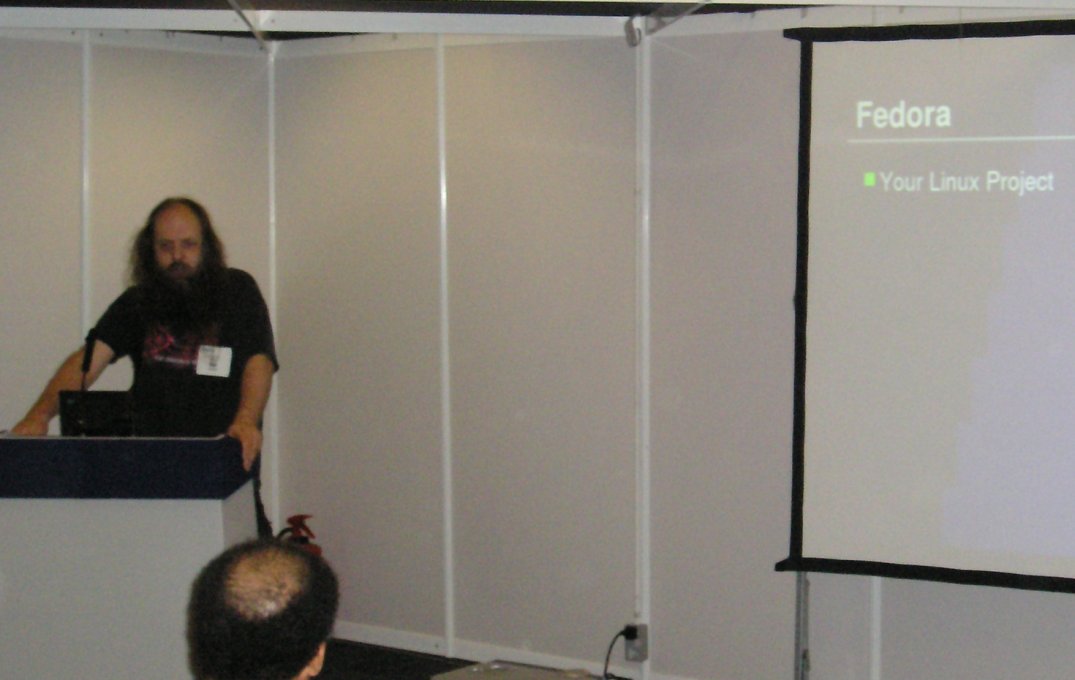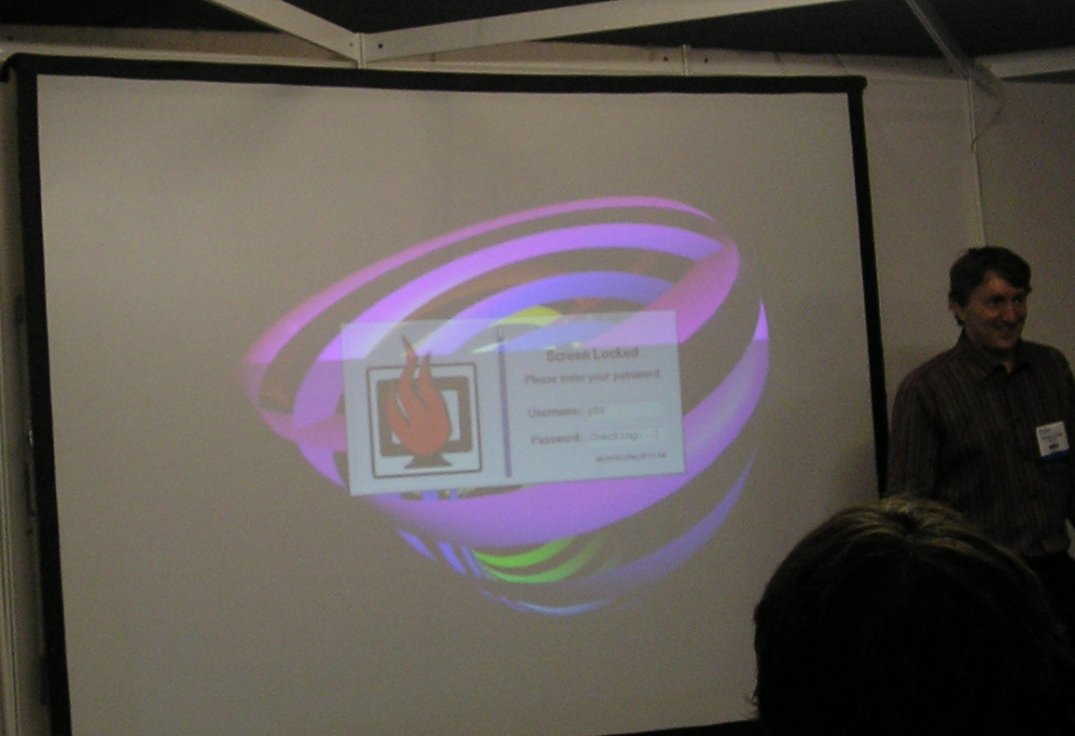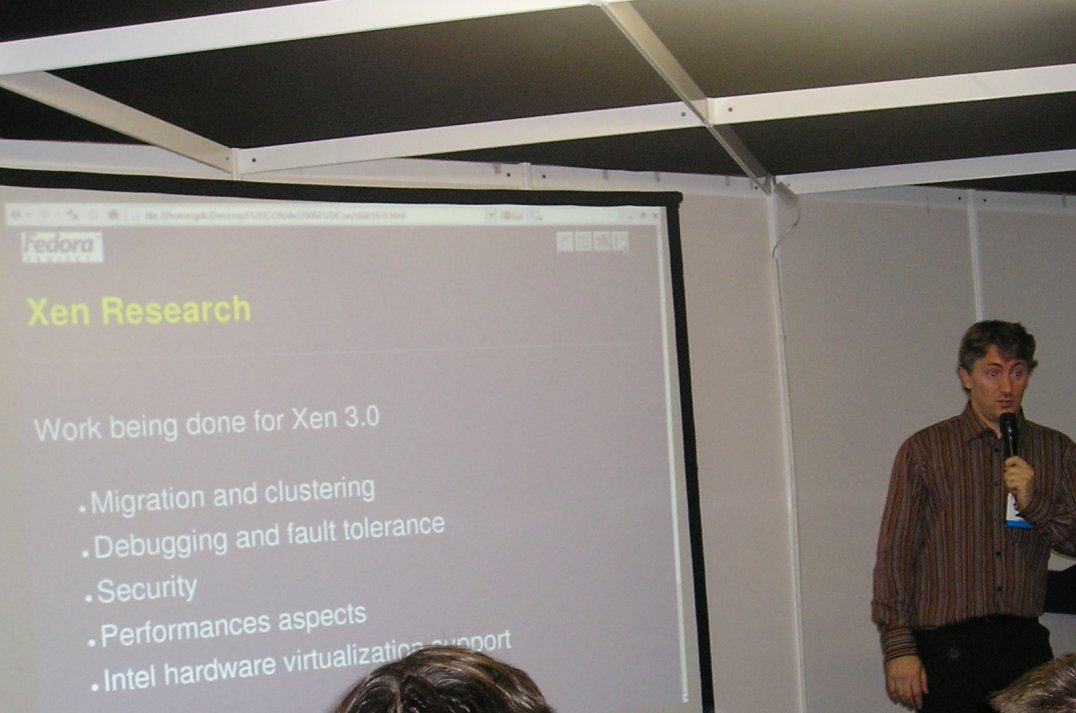I woke up on Thursday 6th October on a friend’s sofa in London where I had spent the night after the Lonix evening get-together after the first day of the LinuxWorld Expo the day before. After a half hour journey recovering on a number 28 bus I arrived at 9.30 a.m. sharp(ish) in time to attend the Fedora Users and Developers Conference (FUDCon) at Olympia.
What is FUDCon?
Recently RedHat organised some special mini-conferences for users and developers of Fedora and are encouraging others to do the same. These mini-conferences are being called “FUDCon”, which is an acronym for “Fedora Users and Developers Conference”. It’s also meant to be a play on words—“FUD Con” or “Against FUD Con”, indicating that they expose some of the “Fear, Uncertainty and Doubt” tactics used by opponents of free software. These conferences are part of the Fedora Project.
These mini-conferences are designed to provide a forum where like-minded Fedora users can meet and generally bond. It currently takes the guise though, of RedHat managers and developers giving presentations to Fedora users and engaging in question/answer sessions and conversations.
Introduction and key notes
This conference was being held at the same venue as the LinuxWorld Expo during its second day, and I had cased the joint on the first. So, I headed directly to the lower ground floor, where I knew the conference was to be held, in order to register and attend. I discovered there, that I was not the only one who had participated in a get-together the night before, and the organisers, largely RedHat employees, and other attendees drifted rather than bounded in, and the conference predictably started slightly late.
The conference was held in two “Conference Rooms”, with a welcoming desk outside them. Here we could purchase a blue wristband that was worth about five pence for £1 to help pay for the conference, and were also given a tee-shirt and a Fedora Code 4 DVD worth considerably more. I was in fact intrigued that RedHat actually possessed pressed FC4 DVDs as I thought they no longer did that after RedHat Linux 9. When I questioned this, it was explained to me they produce five thousand of them on each release to give away at shows and exhibitions. Maybe these will become collectors’ items.

After an extremely informal registration we wandered into “Conference Room 1” where we heard Michael Tiemann, who works for RedHat and has the title of “The Vice President of Open Source Affairs” give a presentation about design in general, and how design plays an important part in the development of Fedora.
After Michael we were treated to a star. Conference Hall 1 significantly filled up when the one and only Alan Cox, a key developer of the Linux kernel, made his modest entrance and granted us an audience. He then proceeded to give us a presentation, going into further detail of the Fedora Core development, touching on the technical side as well.

These two keynotes I found informative and corrected some misconceptions I had about Fedora, Red Hat Enterprise Linux and the relation between the two. Fedora was genuinely designed to be a community project using nothing but free software built around a similar policy to Debian’s, but with a more bleeding edge emphasis. RHEL was designed to be anything but bleeding edge, but rather an enterprise-level stable GNU/Linux distribution, that is well tested, certified and supported by RedHat. They assured us that Fedora was not a beta version of RHEL. They explained why the model wouldn’t work anyway due to the fact that RHEL components wouldn’t be interesting enough for the community. They also confirmed that Fedora was not a continuation of the old RedHat Linux (which ended with RedHat 9), insofar as Fedora doesn’t even attempt to be enterprise resilient, but adopts new technology as and when it becomes available.
Despite the above, there are people who place Fedora Core in mission critical scenarios successfully.
The Developers Track
After Alan Cox’s spiel the conference was split into a “Users’ Track” and a “Developers’ Track”. As I like to think of myself as a programming geek I seated myself in the Conference Room 2, the “Developers’ Track”.

The first presentation for the “Developers’ Track” was given by Florian LaRoche, a developer at RedHat. This presentation delved into the mechanics of free software development, especially at RedHat, and the relationship between RedHat’s paid developers and the development community.
Daniel Veillard then took the stage and presented us with the ins and outs of Xen virtualisation. In doing so, he explained what para-virtualisation was by comparison to the type VM-Ware and others use. He also drew our attention to some not-so-well known features such as the ability to move a virtual machine from one physical machine to another while it is still running. He told us about a demonstration the Xen people like to do, which involves starting an ID Quake server on a virtual machine and having a couple of guys playing on some clients. They then move the server virtual machine and processes to another physical machine showing how the game play isn’t interrupted.

After that Jon Fautley gave a presentation on LDAP and its internals. He also updated us on the Netscape LDAP implementation that RedHat bought from AOL. In short, they are converting as much of it as they can to a free software license. Jon finished his presentation about twenty minutes early which enabled me to go to the cafe and grab a quick lunch.
I returned into the care of Alasdair Kergon, who explained the implementation of LVM on Fedora, some of the lesser known things LVM can do (such as: on-line mirroring), and the whys and hows behind the technology’s present and future progression.

Some details and some of the presentations of this and the rest of the conference can be found at the FUDCon 3 web site.
Finale and conclusion
As a finale we all trooped back into “Conference Room 1” for a “Birds of a Feather” general question and answer session lasting half an hour. At this point, 4:30 p.m. had arrived and it was time for the staff at Olympia to kick us out. Therefore, we departed and I made my way home.

All in all the conference was pleasant and informative. If I have any criticism about it, it is that they did not plan for any comfort breaks or meals during the seven hour conference itself. A fifteen minute coffee break every two hours and a proper half hour lunch break—rather than a single twenty minute dash when a presentation finished early—would have, in my most humble opinion, enhanced the day.
It was good to be able to meet and talk with the RedHat guys, and both my understanding of their strategy and respect for their community commitment has increased. Although the conference was by no means perfect, I would like to give RedHat a full ten out of ten for producing it. I hope to see many more of these, and I would not be surprised to see Novell emulate this in a similar way with their OpenSuse project.